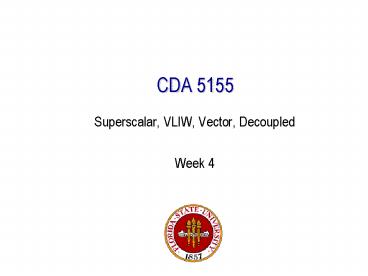CDA 5155 - PowerPoint PPT Presentation
1 / 12
Title:
CDA 5155
Description:
Simplest hardware great for the right problems. Statically Scheduled Multiple Issue. Better known as Very Long Instruction Word (VLIW) Compiler dominated Scheduling ... – PowerPoint PPT presentation
Number of Views:24
Avg rating:3.0/5.0
Title: CDA 5155
1
CDA 5155
- Superscalar, VLIW, Vector, Decoupled
- Week 4
2
Processors Design Families
- Superscalar
- Not an Architectural Specification!
- Vector Processors
- Simplest hardware great for the right problems
- Statically Scheduled Multiple Issue
- Better known as Very Long Instruction Word (VLIW)
- Compiler dominated Scheduling
- Better known as EPIC (almost VLIW)
- Decoupled Architectures
- Tightly interconnected Scalar Processors
- Relatively unknown area, influencing current
designs - (also my dissertation research)
3
Vector Processors
- Im certainly not inventing vector processors.
There are three kinds that I know of existing
today. They are represented by the Illiac-IV,
the (CDC) Star processor, and the TI(ASC)
processor. Those three were all pioneering
processors One of the problems of being a
pioneer is you always make mistakes and I never,
never want to be a pioneer. Its always best to
come second when you can look at the mistakes the
pioneers made - - Seymour Cray (Cray-1 1976)
4
Vector Processor Design
- Early super computers
- Add Special instructions (addV) that operate on
sequences (or vectors) of data - A single instruction defines a long sequence of
operations to be performed. - Sequences do not have hazards no stalling,
forwarding, etc. - Eliminates the need for overhead instructions for
loop iteration - Very simple pipeline organization
- More constrained memory access makes scheduling
LV/SV instructions match memory banking designs - This enables very efficient use of memory bus
(like caches do to a smaller extent)
5
Organization of a Vector Machine
6
Handling Vectors in Memory
- LV V1 ? MemR1
- Loads an entire vector of data starting at
location MR1 - This looks a lot like a cache line fill operation
- Can design the number of memory banks to reflect
the vector size. - What about non-contiguous accesses?
- Column access on a 2D array elements out of a
structure - LV V1 ? MemR1,R2
- Loads vector starting at R1, with a stride of R2
bytes - What about more complex accesses?
- Indexed (scatter/gather) access
- LV V1 ? MemR1, V2
- V11 ? MemR1V21 V12 ? MemR1V22
etc.
7
Pipelining Vectors
8
Chaining Vectors
- Enable forwarding of vectors (DAXPY Z aX Y)
- LV V1, R1 load X
- LV V2, R2 load Y
- MULSV V3, F0, V1 calculate aX
- ADDV V4, V3, V2 calculate (aX) Y
- SV V4, R3 store at Z
- How can we overlap instructions?
9
Other Vector Issues
- Compiler analysis to find vectorizable code
- Determining vector length
- Amdahls law
- Complexity
- Code base
- Image Processing, scientific code (genomes?),
graphics (MMX)
10
VLIW Processors
- What happens to hardware complexity if we make
the microarchitecture (pipeline organization)
visible to the programmer/compiler? - Scheduling is a software problem
- Hazard detection is a software problem
- Memory Scheduling is (mostly) a software problem
- Speculation (branch prediction) is (mostly) a
software problem - Hardware is simpler!
- Compiler/Programmers job is much harder
11
Non-unit latency
- No hazard detection
- If we write code that reads R3, it means whatever
is in R3 at that cycle. - Note that Superscalar will get the most recent
definition (that is what the hazard detector
check for) - R1 ? 5
- R1 ? 10
- R2 ? R1 (5 or 10?)
- It depends on the structure of the pipeline
(which is known by the software) - Pipeline registers are visible to the compiler
(but may not be accessed)
12
Decoupled Processors
Multiple Processors Asynchronous Queues P1 LD
Xi? P3 P2 LD Yi ? P4 P3 Mul a,Mem ? P4 P4
Add P3, Mem ? Mem































